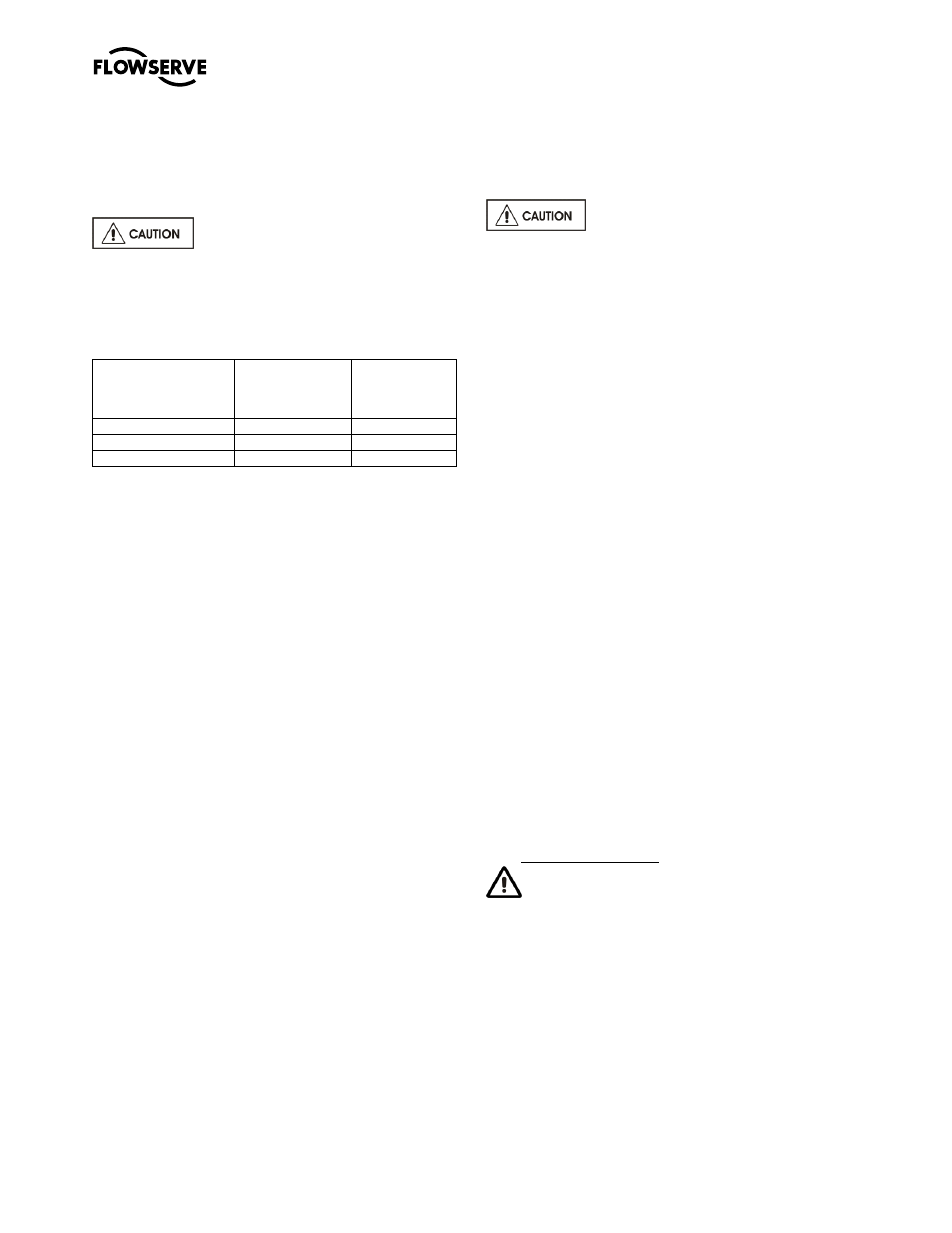8 stopping and shutdown, 9 hydraulic, mechanical and electrical duty, 6maintenance – Flowserve M-series PolyChem User Manual
Page 31

USER INSTRUCTIONS PolyChem M-SERIES ENGLISH 71569218 07-11
flowserve.com
Page 31 of 60
®
5.7.6.2
Normal vibration levels, alarm and trip
For guidance, pumps generally fall under a
classification for rigid support machines within the
International rotating machinery standards and the
recommended maximum levels below are based on
those standards.
Alarm and trip values for installed
pumps should be based on the actual measurements
taken on the pump in the fully commissioned as new
condition. Measuring vibration at regular intervals will
then show any deterioration in pump or system
operating conditions.
Vibration velocity
–
unfiltered
Horizontal pumps
15 kW (20 hp)
mm/s (in./sec)
r.m.s.
> 15 kW (20 hp)
mm/s (in./sec)
r.m.s.
Normal N
3.0 (0.12)
4.5 (0.18)
Alarm N x 1.25
3.8 (0.15)
5.6 (0.22)
Shutdown trip N x 2.0
6.0 (0.24)
9.0 (0.35)
5.8 Stopping and shutdown
5.8.1
Shutdown considerations
When the pump is being shutdown, the procedure
should be the reverse of the start-up procedure. First,
slowly close the discharge valve, shut down the
driver, and then close the suction valve. Remember
that closing the suction valve while the pump is
running is a safety hazard and could seriously
damage the pump and other equipment.
5.9 Hydraulic, mechanical and electrical
duty
5.9.1
Net positive suction head (NPSH)
Net positive suction head - available (NPSH
A
) is the
measure of the energy in a liquid above the vapor
pressure. It is used to determine the likelihood that a
fluid will vaporize in the pump. It is critical because a
centrifugal pump is designed to pump a liquid, not a
vapor. Vaporization in a pump will result in damage to
the pump, deterioration of the Total differential head
(TDH), and possibly a complete stopping of pumping.
Net positive suction head - required (NPSH
R
) is the
decrease of fluid energy between the inlet of the
pump, and the point of lowest pressure in the pump.
This decrease occurs because of friction losses and
fluid accelerations in the inlet region of the pump and
particularly accelerations as the fluid enters the
impeller vanes. The value for NPSH
R
for the specific
pump purchased is given in the pump data sheet, and
on the pump performance curve.
For a pump to operate properly the NPSH
A
must be
greater than the NPSH
R
. Good practice dictates that
this margin should be at least 1.5 m (5 ft) or 20%,
whichever is greater.
Ensuring that NPSH
A
is larger than
NPSH
R
by the suggested margin will greatly enhance
pump performance and reliability. It will also reduce
the likelihood of cavitation, which can severely
damage the pump.
5.9.2
Specific gravity (SG)
Pump capacity and total head in meters (feet) of liquid
do not change with SG, however pressure displayed
on a pressure gauge is directly proportional to SG.
Power absorbed is also directly proportional to SG. It
is therefore important to check that any change in SG
will not overload the pump driver or over pressurize
the pump.
5.9.3
Viscosity
For a given flow rate the total head reduces with
increased viscosity and increases with reduced
viscosity. Also for a given flow rate the power
absorbed increases with the increased viscosity, and
reduces with reduced viscosity. It is important that
checks are made with your nearest Flowserve office if
changes in viscosity are planned.
5.9.4
Pump speed
Changing the pump speed affects flow, total head,
power absorbed, NPSH
R
, noise and vibration levels.
Flow varies in direct proportion to pump speed. Head
varies as speed ratio squared. Power varies as speed
ratio cubed. If increasing speed, it is important to ensure
the maximum pump working pressure is not exceeded,
the driver and magnetic coupling is not overloaded,
NPSH
A
> NPSH
R
and that noise and vibration are within
local requirements and regulations.
6
MAINTENANCE
It is the plant operator's responsibility to ensure
that all maintenance, inspection and assembly work is
carried out by authorized and qualified personnel who
have adequately familiarized themselves with the
subject matter by studying this manual in detail. (See
also section 1.6.)
Any work on the machine must be performed when it
is at a standstill. It is imperative that the procedure for
shutting down the machine is followed, as described
in section 5.8.
